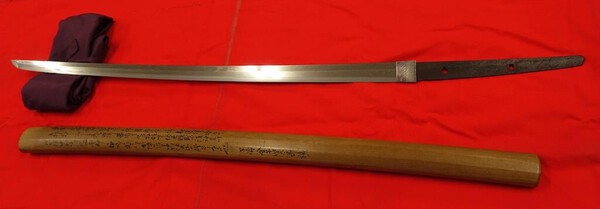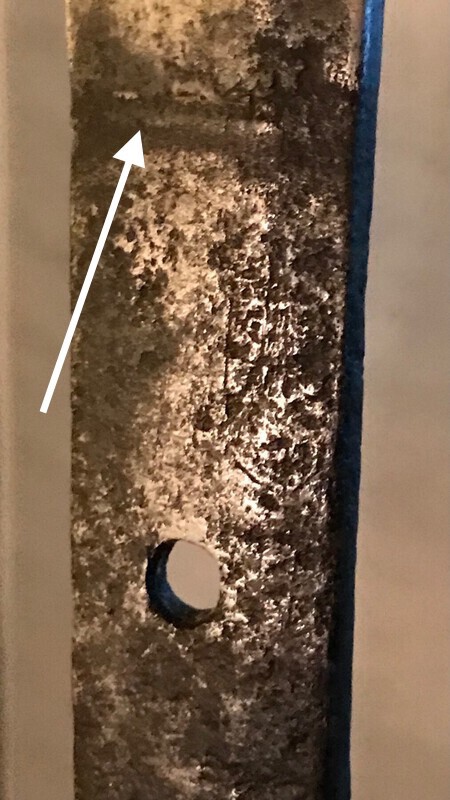-
Posts
147 -
Joined
-
Last visited
Content Type
Profiles
Forums
Events
Store
Downloads
Gallery
Posts posted by French nihonto
-
-
It's really difficult to say. I have the impression that the steel has been heated with something. I hope it's not that because that would be irrecoverable.
Or burnt by a chemical element -
Il y a 1 heure, Matsunoki a dit :
Je supposeque la physique n'est pas votre point fort.
Oh, dear. It's a shame, that's what I do for a living. Maybe I should think about doing something else.


Tanto or Wakizashi is not the point. I had forgotten the size of the blade written in the first post, which I read yesterday quickly between 2 trains. That doesn't make me someone who is bad at physics, at best someone who has memory problems I grant you.
My suggestion was just a basic comparison of weight between 2 blades of the same size. If it's silver, you'll immediately feel it on such a 'large' object.
But we know here that it's not silver.
Sincerely-
 5
5
-
 2
2
-
-
Not easy to do, I agree, but it might be the least invasive solution, apart from the spectrometer. But much less expensive

-
Compare this with a tanto tradionel, which is about the same size. If it's silver, the difference will be significant.
-
 1
1
-
-
I really doubt it's silver.
The simplest test would be to weigh it. Quite simply, silver has a much higher density than steel, aluminium, and so on. Weigh the blade, and you'll see straight away if it's silver or not.-
 1
1
-
-
Very probably Gimei. and for the quality it is difficult to say with these photos. you say that the mune was altered? how is it altered?
-
It's more than a mortal default. It's an earthquake fissure.

-
 3
3
-
 1
1
-
-
1 hour ago, Kanenaga said:
There is also a large one on the other side, lower down toward the nakago.
I've already had this kind of mark on one of my old blades. It's hard to tell from the photos if it's exactly the same on this blade. But sometimes the Shirasaya is a bit too tight and causes blackish rub marks.
-
 2
2
-
-
2 hours ago, Alex A said:
Sans mentionner les noms, mais au courant des revendeurs qui ont essentiellement gagné leur vie en vendant des épées gimei très chères et probables.
I completely agree with you, but is it the blade that is fundamentally dishonest, or is it the merchant who decides to be dishonest?
I'd like to cite an example of a sword that everyone here knows.
Kondo Isami's katana.
It's well known that the Kotetsu of the Shinsengumi chief is actually a fake. But at the time, Kondo simply liked the blade because its steel was pleasant and it cut really well. And it wasn't until the Meiji era that the sword was established as a Gimei. By the end of the Edo period, it was considered Shoshin.
Now what do we do with these blades? Which belonged to these great figures in Japanese history. Because I don't think Kondo was the only big name to wear a Gimei. And even though they knew swords well, many wore this kind of blade, Gimei but effective in combat. These blades are historically important, effective in combat and therefore well made. But it's impossible to find a piece of paper confirming that they're worth keeping, or else you'd have to remove the Mei from this kotetsu? Or give it to a martial artist to train with?

-
 2
2
-
-
1 hour ago, Alex A said:
You guys are talking like all fake mei are a work of art and of reasonable accuracy regarding school/smith, when a lot of time they are utter BS and do nothing whatsoever for the blade, as i said earlier, they are just DISHONEST.
If you want a pink slip or whatever with who they think made the blade, then great, I'm all for that.
This thread seems very suited to folks that own gimei, looking for a reason for some acceptance.
I don't think our own collection has anything to do with this debate. We're just proposing a solution to preserve as many blades as possible for future generations. Just for the study of fake signatures, why they were made, at what time, by whom, for whom? etc... questions that are not yet fully answered. Or do you think the signature is more important than the blade? So a very nice blade with a fake signature shouldn't be studied, nor preserved?
It's a question of study and preservation, not of personal materialism and pecuniary reasons.
In any case, there seems to be no end to this debate.
-
 2
2
-
-
Il y a 27 minutes, Rivkin a dit :
Ehbien, ils ont brûlé Chagal, ce que beaucoup pensaient être réel, mais le tribunal s'est convaincu que ce n'était pas le cas.
This chagal and most other fake chagals come from a single person, a copy artist who has since served time in prison in France. Most of copy date back to the 1970s. So considered the modern age. The decision to destroy the work was made to deter current forgers.
I've already seen an interview with this men who put away the brushes long ago. And he says he sees a lot of these counterfeit paintings in big museums, obviously presented as the real thing.
-
 1
1
-
-
7 hours ago, Rivkin said:
For those concerned with mei removal there is an interesting French law which makes it illegal to own a forgery. France is also known for a plethora of institutions dedicated to publishing catalogue raisonne of specific artists, and such organizations on occasion successfully sue private collectors and museums demanding a painting with what they see as a fake signature (obviously unsigned work cannot be "fake" by definition) to be destroyed alltogether.
A word of clarification. This law is used for modern objects, to protect the very frequently copied luxury goods market. But they won't destroy a 19th-century painting that's a copy of a 16th-century one.
It's not used for ancient objects.-
 2
2
-
-
The uda school especially, and a little Ko-Uda as well, was the easy attribution for the blade that have a difficult reading. And there are many more uda and ko uda attributions than actually created works.
Kunifusa's works are the most highly rated, I think. The Ko-Uda school is relatively good (often a little underestimated, I think), while the Uda school produces rather scholastic blades with less charm. I own a Ko-Uda Tenshō-suriage (type of suriage applied to blades generally appreciated) paper attributed to Kunifusa, and it's a nice work.-
 1
1
-
-
41 minutes ago, Franco D said:
Their game, their rules. Participation is voluntary. Which means that when you decided to voluntarily participate, you agreed to play by the rules.
I'm generally a traditionalist, but aren't rules supposed to evolve sooner or later? Or does everything stay the same indefinitely? The paper system evolved in 1982, after being created in 1948, 34 years later. Now, after 41 years, there's nothing ridiculous about a small update.
Well, maybe one day-
 2
2
-
-
19 minutes ago, Mark S. said:
Maybe a new category? Not quite Hozon, but maybe something else? Someday…
New paper. Clearly recognizable. That doesn't interfere with classic papers and could open up a new field of study. It would be a nice evolution.
-
 2
2
-
-
45 minutes ago, Rivkin said:
I have couple gimei blades that I don't know what to do with because one is published in a major book, another has Shimazu provenance records. I would ordinary erase the signature but...
This will be my last post for this topic, I must sound unpleasant


The heart of the Gimei debate I think. We have all had, or still have, Gimei blades in our collection. Are they of artistic interest and study? yes
Are they historical artifacts? Yes
Are they worth preserving? Yes
Yet the largest organization and authority in the field thinks they're not worthy of preservation. I've always found that strange. This will cause their death in the medium and long term, because we collectors who preserve these objects are increasingly trying to avoid them because they are problematic.
-
 1
1
-
 1
1
-
-
This is indeed a difficult problem to solve.
A dishonest dealer will resell a Gimei blade advertising that the Mei is good because the truth that the blade is Gimei will lower the value of the blade considerably.
A Gimei blade is worth much less than a genuine Mei blade for two fundamental reasons. The main reason is that the blade is less desirable, but also because it cannot be papered.
If gimei blades are paper with a special paper. It is my (perhaps dreamy) hope that the value of the blade on the market will increase. Fraudsters will no longer need to cheat, because the price difference between a gimei and a genuine mei will no longer be so great.
If the seller throws away the special paper. It will become just another paperless blade, harder to sell, and its value will drop.
So there's no reason to do it.In any case, it's a very interesting debate.

-
 5
5
-
 1
1
-
-
I think the debate on Gimei blades will intensify in the coming years. The problem is that a lot of nice blades are well made. Not masterpieces, but blades worthy of preservation are being neglected because they are not attractive to collectors due to their inaccessibility to paper. This lack of appeal will eventually endanger some blades. They end up being abused by amateurs or left to rust. Do we have any solutions? Remove the signature. Not to mention the small financial hit, I've always had a problem with the idea of removing a signature that may be 150, 200, 300 years old, even if it's fake, it's part of the blade's history. The blade won't be any better after that. It's as if Michelangelo had signed a painting by Leonardo da Vinci. We don't care about the signature, it's still a Leonardo da Vinci painting, isn't it?
Second solution that could be brought in: a special paper. In a bright, distinctive color (purple, red...) with the same information as classic hozon paper, specifying that the blade has a false signature. This will have the effect of making Gimei blades more enviable to collectors, encouraging Gimei blade owners to embark on the Shinsa process. And to focus more on the quality of the blade than on its signature.
A little freshening up in the middle, bringing some of the more neglected blades back into the limelight.
And who knows? Maybe some pleasant surprisesBest regards
Max
-
 5
5
-
 1
1
-
-
The geometry of the kissaki seems a little strange compared to the rest of the blade. I have the impression that the blade has been shortened by the kissaki.
-
I don't know why. I have a little Tegai feeling on some pictures?
-
 1
1
-
-
Chinese copy
Max
-
In view of the sugata's shape. (Maybe the photo is misleading) I'll say Shinto, second half Edo
-
the sword is antique but polished to the bone, very tired.
the mount is an amateur assembly.
-
Hello.
bad Chinese copy. sorry john
Max
-
 1
1
-



Sovereign Antiques find from UK
in Auctions and Online Sales or Sellers
Posted
I wonder about this line. It looks a lot like a nakago welding mark